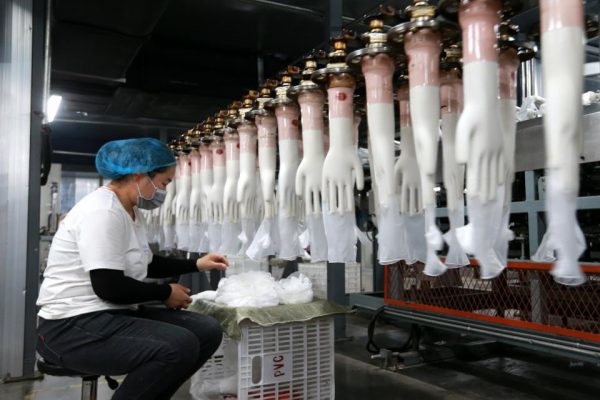What Technology And Manufacturing Can Do To Help Against COVID-19 – Forbes

SUIXI, CHINA – MARCH 23 2020: A staff works on the production line of vinyl disposable gloves at a … [+] manufacturer of medical supplies in Suixi county in central China’s Anhui province Monday, March 23, 2020.- PHOTOGRAPH BY Feature China / Barcroft Studios / Future Publishing (Photo credit should read Feature China/Barcroft Media via Getty Images)
Barcroft Media via Getty Images
It’s time to step up! In a time of crisis, we need to look to our leaders to step up and lead. Whether that’s a politician leading his/her state, a CEO leading an organization, or perhaps the entire tech and manufacturing sector showing it’s agility to adapt, we rely on leaders in times like these.
There has never been a greater test put on manufacturing and supply chains around the world than today. The warts, cracks, and blemishes in the global manufacturing ecosystem are showing their full colors. There’s never been a time when companies need better agility, increased access, and digitization in their supply chain/manufacturing operations. Reading Kathy Wengel’s, Chief Supply Chain Officer at Johnson & Johnson, latest Q&A demonstrates the needs that both large and small companies have.
Kathy isn’t the only leader stepping up and taking on the challenge of COVID-19 and its treatment. We’ve seen an incredible amount of support from the automotive industry, makers building open source respirators, and small medical device companies asking for help. At Fictiv, we started this journey trying to figure out how to manage disrupted supply chains in China and now we’re looking at a global issue with far reaching consequences. How can the technology and manufacturing industries step up when they’re needed? Here are a few thoughts:
#1 – Alternative Manufacturing Methods
Some supply chains, along with their manufacturing processes are under serious threat or even lockdown. Others are recovering from the severe disruption of the last two months and overwhelmed by demand. But some newer technologies, particularly those that are digitally native like additive manufacturing, can offer flexibility, agility and capacity. Just like the example in Italy, there are numerous parts that could be 3D Printed if the current supply chain for that part is disrupted.
And it’s not just additive manufacturing (3D printing), other technologies like CNC can be used to replace parts that come from more heavily tooled industries that may not be able to ramp to meet the current demand. Switching to an alternative manufacturing method could make the difference in getting a part when and where it’s needed.
#2 – Diverting Manufacturing Capacity
In times like this, demand changes daily and industry needs to respond with equal speed. This means companies that normally make jet engines might be asked to respirators, companies that make perfumes might be asked to make surgical wipes, and companies that distill craft gin might be asked to make hand sanitizer on the same equipment. We’ve seen the world’s largest contract manufacturers stepping up to make masks while others prioritize critical healthcare projects.
This is a level of agility not normally seen in the manufacturing space, but one that I know innovators, engineers, and supply chain managers around the world will continue to step up to face. Every day, I am impressed with the level of ingenuity shown and the way technology and manufacturing teams come together to create amazing solutions for consumers, now that ingenuity is being applied to create solutions that can change, and as we’ve seen in the example, save lives.
#3 – Agile Supply Chain Technology
What the world needs right now is a supply chain and manufacturing ecosystem that has the unique and illusive combination of agility and resilience. Where supply chains are digitally enabled there is visibility, and that means assessing or measuring disruption is done quickly or better still in real-time. Thus a backup plan can be quickly deployed. Sadly, many supply chains are not digitally enabled and they have been shown to be less robust in times of great stress.
Those that are agile have adapted, shifted resources, and moved manufacturing to ensure continuity of supply. If a company is making critical equipment or consumables that are used in medical or testing processes, those supply chains need to be robust. And if something happens they need to be able to adapt at lightning speed to ensure that a disrupted supply chain does not mean failure to deliver.
#4 – Come Together, Share Insights, Get Creative
What we also need right now is to come together, to share ideas and to help each other achieve those ideas. We are without doubt at our most innovative, creative and powerful when we work together as a team. Technology and manufacturing companies, even fierce competitors need to work together right now. Let’s face it – when technologies and people work in unison, magic happens.
Last week, I spoke with Philip Stoten, manufacturing and supply chain journalist, and Scott Miller, CEO of Dragon Innovation, about the connectivity of global supply chains and how companies can recover and prepare for the next inevitable unanticipated disruption. Sharing ideas in an open forum is an important connection, especially in the current climate.
I’d encourage everyone to communicate more, to reach out and ask for help, to share ideas, and to get creative. Technology has a lot to offer and right now we need everyone to step up.
In the future, we can look back and say why supply chains failed and fix those issues. We’ll create better and more resilient technologies, more agile and robust supply chains and we’ll be ready for the next crisis, but right now let’s leverage technology to help in any and every way we can!





